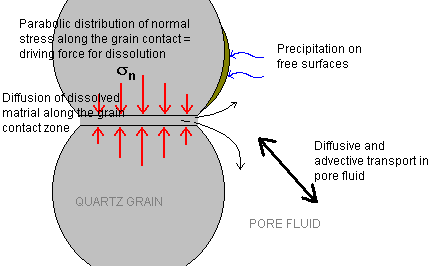Modelling pressure
solution: an example of deformation and reactive fluid flow in a geological
systemPhD at the University of Liverpool funded by NERC and Enviros
QuantiSci Ltd.
Fluid flow, chemical
reactions and deformation are coupled processes that occur in virtually all
geological systems, e.g.
- Compaction-driven
melt migration in partially molten rocks
- Coupled
metasomatism and deformation e.g. in shear zones
- Diagenesis and
compaction in sediments
In order to
understand such systems, it is important to consider the interactions between
processes, rather than considering each process in isolation.
Heather Sheldon is
currently developing a numerical model of pressure solution in quartz
sandstones as an example of a system involving feedbacks between stress,
chemistry and fluid flow. The key issues in this work are:
- To identify the
equations that describe fluid flow, deformation and solid-fluid interactions in
a quartz sandstone undergoing compaction by pressure solution;
- To identify and
implement a numerical method for solving the coupled system of
equations.
Equations
describing pressure solution
T
he strain rate of a rock undergoing pressure solution ultimately
depends on the rate at which dissolved material can diffuse out of the grain
contacts (Fig.1). This depends on:
- normal stress
acting on the grain contact
- rate of
dissolution (kinetics)
- effective
diffusion coefficient in the contact zone (depends on D and thickness of fluid
layer)
- rate of removal of
solute from the pore fluid by: precipitation on free grain surfaces (kinetics)
& diffusive/advective transport through the pore spaces
Therefore, a flow law
describing pressure solution should include all of these factors, and must be
coupled with equations that describe the evolution of pore fluid chemistry due
to solid-fluid reactions and macroscale transport.
 |
Figure 1 - The mechanism of pressure solution between 2 quartz
grains. Which of these processes is the rate-limiting step? |
Developing the
numerical model for pressure solution
- The equaitons
describing solid deformation, fluid flow and chemical evolution of the pore
fluid are tightly coupled and highly non-linear, making them difficult to
solve.
- Recent
developments in the solution of Differential Algebraic Equation (DAE) systems
can be applied to this set of equations.
- A DAE solver
developed by the CASE partners in this project, Enviros QuantiSci Ltd., is
currently being investigated as a method for solving the pressure solution
equations.
Future
work
It is hoped that this
modelling technique can be adapted to investigate other geological systems,
such as melt migration in cumulate crystal piles within magma chambers. Can
coupled modelling of reactive fluid flow and deformation explain such phenomena
as the formation of chemical layering in cumulate rocks (Fig.2)?
 |
Figure 2 - Textural layering
cross-cut by chemical layering in an igneous cumulate (Rhum,
UK) |